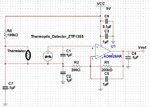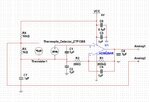kuro_ng
Newbie level 6
Hey all,
If anyone who has knowledge on this please help me out, I would really appreciate it.
I"m doing a project which make a Infrared thermometer. The requirement of the project is that I need to do everything so I could not use the awesome MLX90614
.
I use the ztp 135 sr as my thermopile
. It is an analog sensor which has ambient thermistor. I use 5 volt supply and I connect my preamp and thermistor from the same supply
What I do is I connect the ztp135 to the low noise, low signal preamp AD8628
with 1000 gain. The output from the ztp135 is around 1.8 mV then 1000 gain with capacitors involved I got out only .288 V but it's increase when I point the sensor ztp135 to a high temperature. So I'm assume I'm doing right.
The question I want to ask is how could I connect the signal out from preamp AD8628 to the micro-controller to test if the whole signal I make is working, cause right now I can only see the voltage increase if I point to higher temperature.
I'm using the ATMEGA328
which has the analog to digital converter option.
Do I need to connect to an I2C bus then connect to the ATMEGA 328? I asked so because most of the example I see they using the I2C bus which is the MLX90614 has. If I have to, how would I connect my preamp output to it, and what is the specific I2C product that I could use.
Thanks you very much to take ur time to help me out. Any suggestion would be appreciated.
If anyone who has knowledge on this please help me out, I would really appreciate it.
I"m doing a project which make a Infrared thermometer. The requirement of the project is that I need to do everything so I could not use the awesome MLX90614
HTML:
http://www.sparkfun.com/datasheets/Sensors/Temperature/MLX90614_rev001.pdfI use the ztp 135 sr as my thermopile
HTML:
http://www.ge-mcs.com/download/temperature/920_159a.pdfWhat I do is I connect the ztp135 to the low noise, low signal preamp AD8628
HTML:
http://www.ge-mcs.com/download/temperature/920_159a.pdfThe question I want to ask is how could I connect the signal out from preamp AD8628 to the micro-controller to test if the whole signal I make is working, cause right now I can only see the voltage increase if I point to higher temperature.
I'm using the ATMEGA328
HTML:
http://www.atmel.com/dyn/products/product_card.asp?part_id=4720Do I need to connect to an I2C bus then connect to the ATMEGA 328? I asked so because most of the example I see they using the I2C bus which is the MLX90614 has. If I have to, how would I connect my preamp output to it, and what is the specific I2C product that I could use.
Thanks you very much to take ur time to help me out. Any suggestion would be appreciated.





